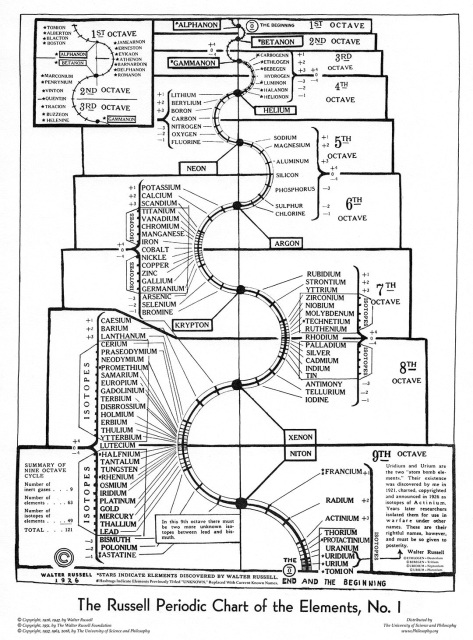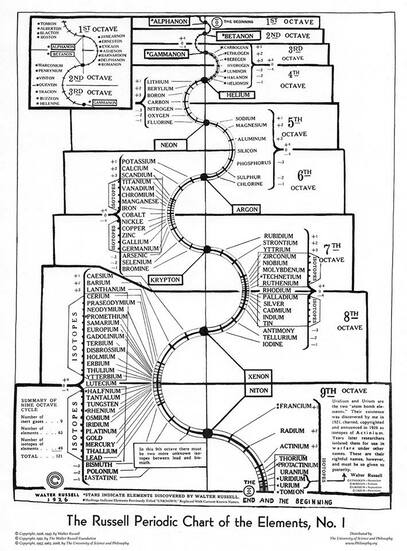The Russell Periodic Chart of the Elements #1
SKU:
AW01
$10.00
$10.00
Unavailable
per item
NEW 2018 EDITION - Elements previously titled "UNKNOWN" have been updated with the current modern day names.
The Russell Periodic Charts of the Elements were first published in 1926 in Walter Russell’s explication of his Cosmology in The Universal One. The charts, based on Russell’s insight into the nature of periodicity, completed the Mendeleev Chart.
Poster Size: 15 ½” x 21 ½”
Click here for the Complete Poster Set
***Shipping may be delayed from standard orders as posters are shipped separately in tubes.***
Free domestic shipping on orders of $50+
The USP is pleased to announce a NEW 2018 POSTER EDITION of “The Russell Periodic Chart of The Elements.” Along with some digital restoration done, the seven elements previously titled "UNKNOWN" in the older chart have been updated with the current modern day names. Walter Russell’s revolutionary periodic chart is now officially complete.
The public release of his periodic chart in 1926 had a profound and explosive effect upon the world. He sent this chart contained in his book, “The Universal One” to all the world of science without receiving any official recognition for this greatest of all contributions to science. Along with his lectures he made possible the discovery of many new elements renamed by chemists and enabled metallurgists to create new powerful alloys. In truth, Dr. Russell was the first to give knowledge of the existence of plutonium, neptunium, deuterium and tritium to the world.
Due to the high degree of accuracy, “The Russell Periodic Chart of The Elements” is still the most advanced periodic chart to date.
Don’t delay! Be one thousand years ahead in YOUR Knowledge of the Elements and ORDER The New 2018 Poster Edition TODAY!
The public release of his periodic chart in 1926 had a profound and explosive effect upon the world. He sent this chart contained in his book, “The Universal One” to all the world of science without receiving any official recognition for this greatest of all contributions to science. Along with his lectures he made possible the discovery of many new elements renamed by chemists and enabled metallurgists to create new powerful alloys. In truth, Dr. Russell was the first to give knowledge of the existence of plutonium, neptunium, deuterium and tritium to the world.
Due to the high degree of accuracy, “The Russell Periodic Chart of The Elements” is still the most advanced periodic chart to date.
Don’t delay! Be one thousand years ahead in YOUR Knowledge of the Elements and ORDER The New 2018 Poster Edition TODAY!
|
"Uridium and Urium are the two "Atom Bomb Elements." Their existence was discovered by me in 1921, charted, copyrighted and announced in 1926 as isotopes of Actinium. Years later researchers isolated them for use in warfare under other names. These are their rightful names, however, and must be so given to posterity." ~ Water Russell
Walter Russell officially discovered these Elements FIRST!
ETHLOGEN = Deuterium |
An Enthusiastic Letter from a Chemist to Walter Russell
He was given a copy of "The Russell Periodic Chart of the Elements" before its release in "The Universal One."
January 8, 1925
Dear Mr. Russell:
What I told you last night of your chart of the six octave working range is not one-one hundredth of one percent of what I think of it. It is difficult to put into words something which seems like a miracle, but it would be easy to put into words an expected discovery which happens almost every day. I am very sure that no chemist ever expected such a workable chart as yours brought out of the darkness of theory into the light of practical everyday work.
I know it will be the greatest thing for chemists and metallurgists today. I can readily see that when the metallurgists apply it they should be able to make alloys more suited to their needs, and especially should it apply to the improvement of steel.
There are many instances where metallurgists must produce alloys of many varying properties to meet their needs, which they can now do with certainty and exactness by a study of your chart, instead of working for months to approximate their intent.
I have picked out a number of unstable compounds that took years of research work to formulate. If these experimenters had your chart to reason from they would have known offhand whether the compounds would be stable or unstable. I really must say all the knowledge a chemist needs is to memorize the chart and be handed the complete command of chemistry. I do wish that the chemists who are working day and night on some research problems could only see it. For heaven's sake Mr. Russell get it copyrighted speedily and give the chemist of today a chance to save time and labor.
I have produced an alloy in my laboratory that would have taken me months and months of research if I had not had this and other of your charts before me to reason from. I am quite sure they will do to chemistry what the steamship did for transportation.
Thanking you for the confidential loan of your charts, which confidence believe me will not be violated, I am,
Sincerely yours,
Robert B.
Manufacturing Chemists
KnickerBocker Products Laboratories
He was given a copy of "The Russell Periodic Chart of the Elements" before its release in "The Universal One."
January 8, 1925
Dear Mr. Russell:
What I told you last night of your chart of the six octave working range is not one-one hundredth of one percent of what I think of it. It is difficult to put into words something which seems like a miracle, but it would be easy to put into words an expected discovery which happens almost every day. I am very sure that no chemist ever expected such a workable chart as yours brought out of the darkness of theory into the light of practical everyday work.
I know it will be the greatest thing for chemists and metallurgists today. I can readily see that when the metallurgists apply it they should be able to make alloys more suited to their needs, and especially should it apply to the improvement of steel.
There are many instances where metallurgists must produce alloys of many varying properties to meet their needs, which they can now do with certainty and exactness by a study of your chart, instead of working for months to approximate their intent.
I have picked out a number of unstable compounds that took years of research work to formulate. If these experimenters had your chart to reason from they would have known offhand whether the compounds would be stable or unstable. I really must say all the knowledge a chemist needs is to memorize the chart and be handed the complete command of chemistry. I do wish that the chemists who are working day and night on some research problems could only see it. For heaven's sake Mr. Russell get it copyrighted speedily and give the chemist of today a chance to save time and labor.
I have produced an alloy in my laboratory that would have taken me months and months of research if I had not had this and other of your charts before me to reason from. I am quite sure they will do to chemistry what the steamship did for transportation.
Thanking you for the confidential loan of your charts, which confidence believe me will not be violated, I am,
Sincerely yours,
Robert B.
Manufacturing Chemists
KnickerBocker Products Laboratories



